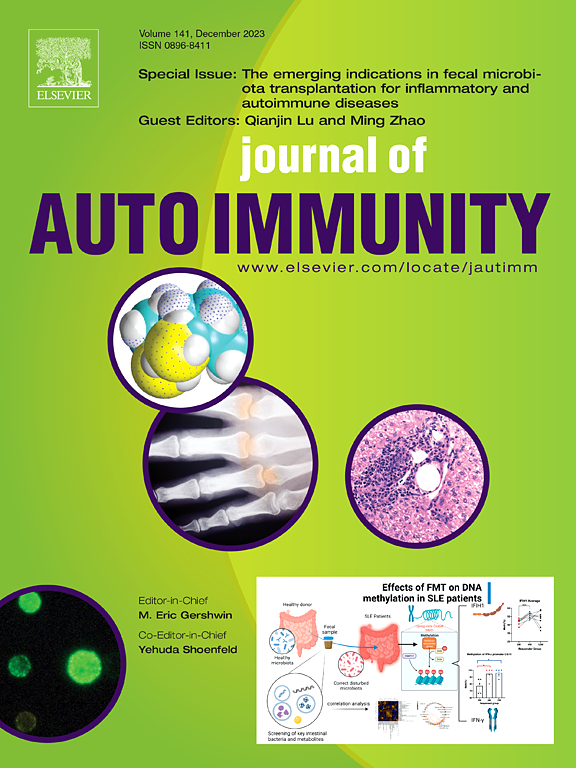Lymphoma driver mutations at the root of somatic evolution of nerve-damaging autoantibodies in myelin associated glycoprotein neuropathy
IF 7
1区 医学
Q1 IMMUNOLOGY
引用次数: 0
Abstract
Background
In autoimmune disease it is not understood how self-reactive B cells escape immune tolerance checkpoints to produce pathogenic autoantibodies.
Objective
In patients with demyelinating polyneuropathy caused by IgM autoantibodies against myelin associated glycoprotein (MAG) and the sulphated trisaccharide CD57, we aimed to test the hypothesis that B cells making the autoantibody escaped tolerance by acquiring lymphoma driver somatic mutations.
Methods
Deep single-cell RNA, DNA, flow cytometric and antibody specificity analysis of blood from three patients with MAG neuropathy.
Results
MAG autoantibody-producing B cell clones exhibited extensive intraclonal immunoglobulin V(D)J hypermutation. In many of the sub-clonal branches, the replacement:silent ratio of V-region mutations was not different from that expected for unselected mutations, although in some branches the mutations either increased or eliminated binding to MAG and CD57 autoantigens. Prior to intraclonal V(D)J diversification, each clone had acquired a gain-of-function MYD88p.L265P mutation, and some branches had acquired additional somatic mutations in CXCR4, IGLL5 and BTG2. Whilst all MAG-binding clones harboured the MYD88p.L265P mutation, the same mutation was also found in some control, polyclonal B cells. Deep sequencing of different blood cell subsets indicated MYD88p.L265P was confined to B cells.
Conclusion
In three MAG neuropathy patients we find evidence that the self-reactive B cells responsible for their disease acquired a classical lymphoma driver somatic mutation early in their clonal expansion.
髓鞘相关糖蛋白神经病中神经损伤自身抗体体细胞进化的淋巴瘤驱动突变
在自身免疫性疾病中,自身反应性B细胞如何逃脱免疫耐受检查点产生致病性自身抗体尚不清楚。目的对由抗髓鞘相关糖蛋白(MAG)和硫酸三糖CD57的IgM自身抗体引起的脱髓鞘性多神经病变患者,验证产生自身抗体的B细胞通过获得淋巴瘤驱动体细胞突变来逃避耐受性的假设。方法对3例MAG神经病变患者血液进行单细胞RNA、DNA、流式细胞术及抗体特异性分析。结果mag自身抗体产生的B细胞克隆表现出广泛的克隆内免疫球蛋白V(D)J高突变。在许多亚克隆分支中,v区突变的替代沉默比与未选择突变的预期没有什么不同,尽管在一些分支中突变增加或消除了与MAG和CD57自身抗原的结合。在克隆内V(D)J多样化之前,每个克隆都获得了MYD88p的功能获得。L265P突变,一些分支在CXCR4、IGLL5和BTG2中获得了额外的体细胞突变。而所有mag结合克隆都含有MYD88p。L265P突变,在一些对照多克隆B细胞中也发现了相同的突变。不同血细胞亚群的深度测序显示MYD88p。L265P局限于B细胞。结论在3例MAG神经病变患者中,我们发现导致其疾病的自反应性B细胞在克隆扩增早期获得了典型的淋巴瘤驱动体细胞突变。
本文章由计算机程序翻译,如有差异,请以英文原文为准。
求助全文
约1分钟内获得全文
求助全文
来源期刊

Journal of autoimmunity
医学-免疫学
CiteScore
27.90
自引率
1.60%
发文量
117
审稿时长
17 days
期刊介绍:
The Journal of Autoimmunity serves as the primary publication for research on various facets of autoimmunity. These include topics such as the mechanism of self-recognition, regulation of autoimmune responses, experimental autoimmune diseases, diagnostic tests for autoantibodies, as well as the epidemiology, pathophysiology, and treatment of autoimmune diseases. While the journal covers a wide range of subjects, it emphasizes papers exploring the genetic, molecular biology, and cellular aspects of the field.
The Journal of Translational Autoimmunity, on the other hand, is a subsidiary journal of the Journal of Autoimmunity. It focuses specifically on translating scientific discoveries in autoimmunity into clinical applications and practical solutions. By highlighting research that bridges the gap between basic science and clinical practice, the Journal of Translational Autoimmunity aims to advance the understanding and treatment of autoimmune diseases.
 求助内容:
求助内容: 应助结果提醒方式:
应助结果提醒方式:


